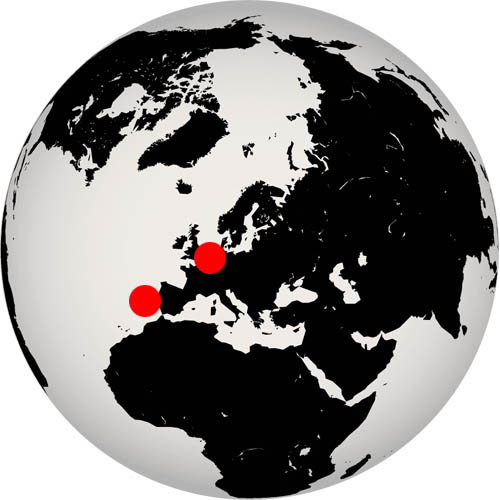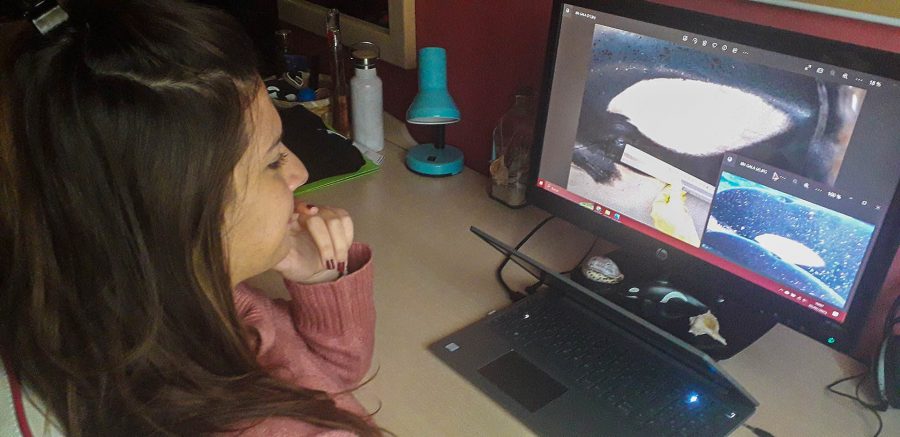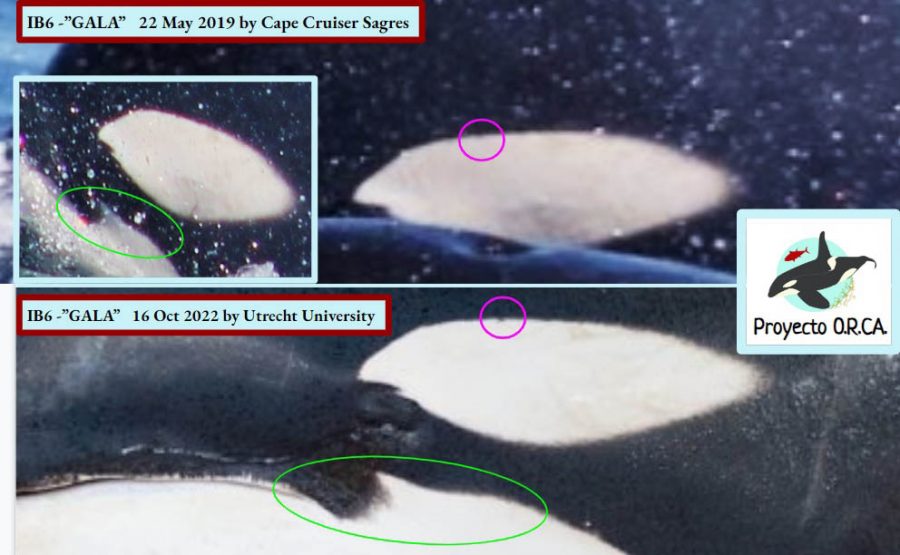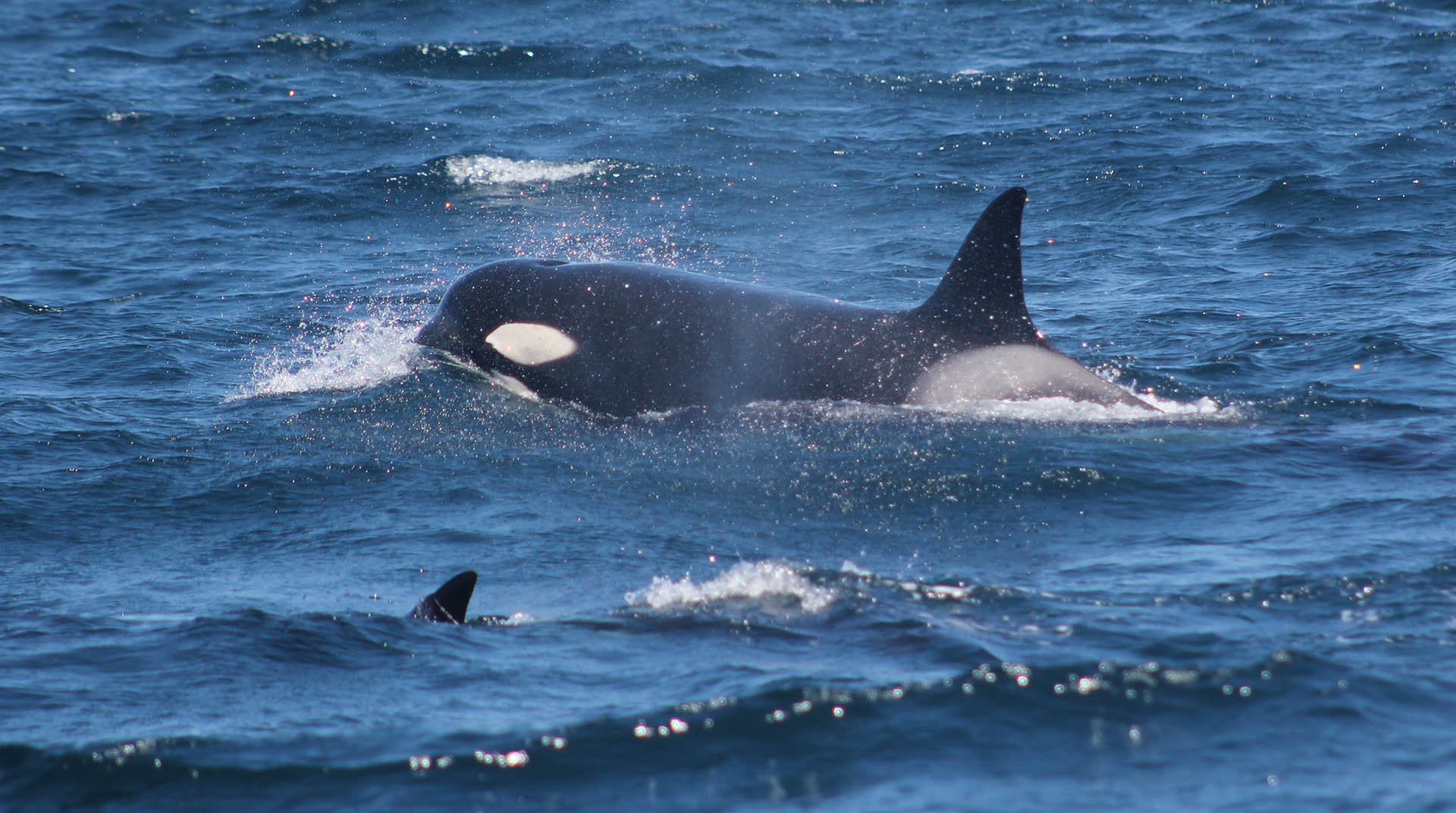There is a unique place for orca lovers on planet earth located in the south of Spain, in a small village called Atlanterra. The ‘Cave of the Orcas’ is a pilgrimage site for every orca lover and should be on your list to visit if you are an avid admirer of these intelligent animals. This cave, over 5000 years old, was used to spot orcas in the sea and as a calendar, marking the arrival of tuna fish to the Strait of Gibraltar. I dedicated my first visit to the Cave of the Orcas to an Iberian orca called Gala, who passed away on October 15th, 2022 in Cadzand, Netherlands. This is her story.
Written by Laura Levinskaite / May 2023
 Hikers on the beach in Cadzand looked surprised when a large black fin emerged between the waves. Orcas are rare in the Dutch part of the North Sea, and especially so close to the shore. The last time an orca was seen was in 2010, when it was a young, emaciated orca named Morgan that was rescued and remained in captivity. Thanks in part to social media, many people came to see the orca in Cadzand. The animal was rolling in the waves and clearly in distress. There were reports of a second orca, but this could not be confirmed. A team from the KNRM (Royal Netherlands Sea Rescue Institution) managed to bring the stranded orca back to deeper water. To their relief, the animal swam towards open sea.
Hikers on the beach in Cadzand looked surprised when a large black fin emerged between the waves. Orcas are rare in the Dutch part of the North Sea, and especially so close to the shore. The last time an orca was seen was in 2010, when it was a young, emaciated orca named Morgan that was rescued and remained in captivity. Thanks in part to social media, many people came to see the orca in Cadzand. The animal was rolling in the waves and clearly in distress. There were reports of a second orca, but this could not be confirmed. A team from the KNRM (Royal Netherlands Sea Rescue Institution) managed to bring the stranded orca back to deeper water. To their relief, the animal swam towards open sea.
At the beach again
An hour later, unfortunately, the orca stranded again. This time a few kilometers to the south. When large cetaceans wash up in the Netherlands, the ‘whale protocol’ comes into effect. The orca was too large for rehabilitation, and the first attempt to bring her back to sea had failed. The only options left were to do nothing or to euthanize the animal. The rescue teams had to make the difficult decision to not interfere with the animal anymore, as pulling it back into the sea would injure the orca further, causing damage to her muscles and tendons. Throughout the evening, curious bystanders were kept at a distance while the fire department kept the orca wet. It was a bizarre sight to see the helpless animal lying there. Occasionally, the head or tail moved slightly and a puffing breath sound was heard. Shortly before midnight, the animal began to experience agony. To ease her suffering, the orca was given sedatives, after which she finally passed away peacefully.

Gala just after she died (© Jeroen Hoekendijk)
Finding the match
Who was this orca? And where did she come from? Everyone was very curious about that. Photos were shared with organizations that monitor and document orca populations. Because of the location where the animal was found, everyone looked to Icelandic and Norwegian orca identification catalogs. However, the orca looked familiar to Paula Moreno, co-founder of Proyecto Orca Cadiz. Even though the animal was stranded far from the Spanish coast, she decided to look at the Iberian orca catalog and found a match. “I have received good quality pictures of her taken during the necropsy. The dorsal fin was damaged and unrecognizable from the photos. But the eye patch photos were of perfect quality, and I searched in the archives for similar ones and found a match,” stated Paula Moreno. Proyecto ORCA-Cádiz, a Spanish animal protection organization dedicated to the conservation of protected orcas, was the first to identify the orca as Gala IB6.

Matching process (© Proyecto Orca Cadiz)

It’s in the details (© Proyecto Orca Cadiz)
According to Proyecto Orca, Gala was estimated to be at least 30-40 years old. She was first cataloged in the early 2000s as a fully grown adult. Before her stranding, there was no registered sighting for three years. Measurements taken after her death showed that Gala was 5.5 meters long and weighed 2003 kilograms. Very little is known about Gala because of her elusive behavior, but she was always accompanied by her son Titan IB13. He was cataloged as a fully grown adult when he was approximately 20 years old. Could Titan be the other orca that was seen in Cadzand? Gala belonged to a population that lives around the Iberian Peninsula. In May 2023, Proyecto O.R.CA announced that these animals have also been seen in the Azores. The stranding of Gala marked the furthest recorded migration of Iberian orcas. She was a member of the “Lusas” clan. These whales prefer Portuguese waters and are very rare to spot in the Strait of Gibraltar, and have occasionally been seen off the French coast, in the Bay of Biscay.
“Very little is known about Gala because of her elusive behavior, but she was always accompanied by her son Titan IB13.”
Critically endangered population
The death of orca Gala is a tragic loss for the Iberian orca population, as there are fewer than 50 individuals left. Iberian orcas are considered critically endangered due to the many problems they face, including noise pollution from marine traffic in the Strait of Gibraltar, possible attacks by tuna fishermen, and pollution from plastics, nets, and toxic waste. Orcas that began feeding on tuna caught with long lines in the Las Bajas area of the Strait of Gibraltar in the early 1990s are called “Gaditanas” and are at risk of attacks by fishermen. Gala, however, was not known to interact with tuna fishermen or vessels. Recently, there have been numerous reportsof an unusual and unique behavior of some juvenile Iberian orcas. They have been known to interact with (sailing) vessels, breaking or deforming the rudder and leaving them without steering and in need of repair. To protect and conserve the orcas, two key areas require attention. First, close monitoring of the population is needed to evaluate whether it is increasing or decreasing. Second, official and legal measures are required to prevent damage caused by interactions between humans and animals.

Gala together with her family in Portugese waters (photo: © Cape Cruiser Sagres)

Gala’s teeth are badly worn and rotten. (© Jeroen Hoekendijk)
Cause of death
Gala’s body was taken to the Faculty of Veterinary Medicine of Utrecht University, where a necropsy was performed. In cooperation with Wageningen Marine Research, they investigated the causes of Gala’s death. According to the official statement “Numerous internal infections, gum disease, an empty stomach, and intestines showed that she had not eaten for some time.” The orca was emaciated, and all of its teeth were weak and rotting, which would have caused a lot of pain while eating. The animal was seriously ill and weakened, with inflammation found in several internal organs, including the heart valve, three layers coating the brain called meninges, and the reproductive organ. Examination of the stomach and intestines revealed that the orca was malnourished. Gala’s 4 stomachs and 30-meter-long intestines were empty, and only one small plastic tarp was found, which had no impact on the cause of death. The necropsy could not provide valuable information about Gala’s diet. Finally, the Naturalis Biodiversity Center in Leiden will preserve the orca’s skeleton for future generations. The skeleton will undergo a series of cold and warm rinsing baths with enzymes until all the fat has disappeared from the bone tissue. Then it will be dried and bleached. This process may take about six months.
Reminder
Gala was commemorated in the launch of the Proyecto Orca Cadiz catalogue, which is the first completed catalogue of the Iberian orca population. Her name, which in French means “celebration”, will forever shine in our hearts. She will serve as a reminder that if nothing is done to protect this orca population now, it will be too late.
![]()
About Proyecto Orca Cadiz:
 Proyecto O.R.CA is a working group that aims to raise awareness about the dangers faced by the orca population and the need for their protection and conservation as a threatened species. Our team consists of volunteers united by their passion for orcas. For over a decade, we have been monitoring the population through social media and collaborating with others who share our passion. We strongly believe in cooperation and that great things happen when people come together to share and enjoy valuable information about these magnificent creatures.
Proyecto O.R.CA is a working group that aims to raise awareness about the dangers faced by the orca population and the need for their protection and conservation as a threatened species. Our team consists of volunteers united by their passion for orcas. For over a decade, we have been monitoring the population through social media and collaborating with others who share our passion. We strongly believe in cooperation and that great things happen when people come together to share and enjoy valuable information about these magnificent creatures.
![]()
Want to know more about the Iberian orcas?
GT Orca Atlántica is an organization dedicated to the protection and management of the Iberian killer whales. They work together with various organizations on ecobiology, interactions with boats and safety. A lot of interesting information can be found on their website, such as their own catalog in which the Iberian orcas can be found with other ID codes.: www.orcaiberica.org

 Nederlands
Nederlands
